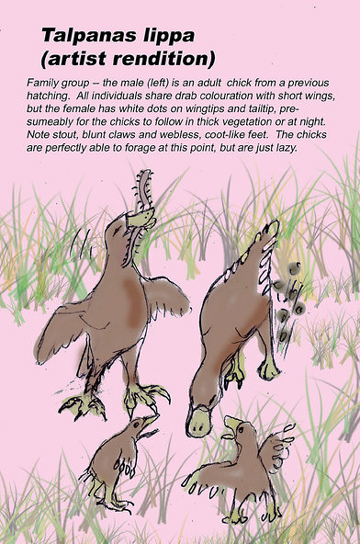
Waterfowl (or wildfowl, or anseriforms, or ducks, geese, swans and kin) are awesome. Last year saw the publication of a particularly freakish, recently extinct member of the group that's been known to some of us for a while: the surreal Hawaiian duck Talpanas lippa Olson & James, 2009 from Kauai*. I'll admit that I missed the memo (didn't know about publication until Glyn Young sent me a pdf), even though Chris Taylor at Catalogue of Organisms wrote about Talpanas on its publication.
* Note that Talpanas joins that very annoying list of names where the authorship of the taxon [Olson & James] is different from the authorship of the paper [Iwaniuk, Olson & James]: why do people do this? This makes it look as if naming the taxon is the bit that deserves the credit (a criticism previously made by Landry (2005) concerning the naming of the Kipunji Rungwecebus kipunji), not the production of a paper on it.
So far as I know, only the braincase, posterior part of the lower jaw, tarsometatarsus and posterior part of the pelvis of Talpanas have been described (Iwaniuk et al. 2009). By comparing the measurements of these elements with those of other waterfowl, Iwaniuk et al. (2009) were able to estimate a body mass for Talpanas (692-1072 g, about equivalent to a Northern pintail Anas acuta), and establish how peculiar its proportions were. Its tarsometatarsus was proportionally small, so it was short-legged, and its shape best matches that of heavy-bodied terrestrial waterfowl.
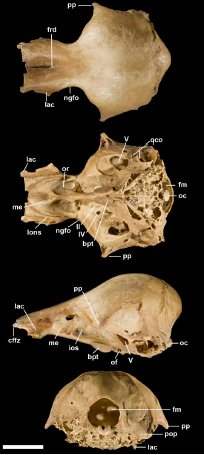
The most interesting features are seen in its braincase [shown here, from Iwaniuk et al. (2009). Scale bar = 10 mm]. It had very small eyes and small optic nerves (and hence poor vision), while the trigeminal nerve (associated with relaying tactile information from the face and mouth) was huge. The nasal cavity was large compared to that of other waterfowl, extending posteriorly (into the region normally occupied by the eyeballs!) to reach the braincase. What's known of the palate suggests that the bill was broad-based, but we don't know anything definite about the shape of the whole bill.
Combined, these features suggest that Talpanas was a small-eyed, flightless, stout-legged duck that relied on smell and tactile foraging. Iwaniuk et al. (2009) concluded that it was a kiwi-mimicking duck that foraged nocturnally, presumably in sediment or leaf litter. The fact that an enlarged trigeminal nerve is also present in platypuses 'raises the intriguing possibility that Talpanas may have relied on more than simple tactile input in prey detection' (p. 66). Larry Witmer tells me that work underway on the skull reveals some exciting further insights... but, alas, no evidence for an electroreceptive ability.
It seems only natural to wonder what Talpanas looked like when alive. The known bits and pieces aren't used by Iwaniuk et al. (2009) to create a skeletal reconstruction or life restoration: despite the fragmentary nature of the remains, enough of the animal is known to produce at least a schematic reconstruction, but you might argue that this would be too speculative an exercise, given that we don't know such things as dorsal column length, bill shape and so on. Purely for fun - it is NOT meant to be taken seriously! - I knocked up the image shown below a few weeks ago. Inspired, Holly Nelson produced the colour picture shown at the very top. Please note that they are not scientifically rigorous life restorations - err, far from it... they're cartoons - and we await the appearance of proper, accurate renditions of this animal.
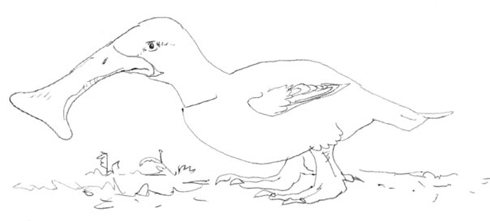
These pictures could well be criticised for not being weird enough. Should the nostrils be terminal, as in a kiwi? Hanneke Meijer asked why I hadn't fitted the duck out with kiwi-like whiskers, and I'll admit it's possible that the duck had peculiar sensory organs that made it different from other waterfowl. However, my assumption is that it used a hypertrophied, super-tactile bill as its main foraging organ, and I had such species in mind as the Pink-eared duck Malacorhynchus membranaceus.
If you know anything about Hawaiian birds, you'll know that they were catastrophically affected by human hunting and habitat change. About 40 species were made extinct over the last 1500 years, including a variety of spectacular flightless waterfowl. The Talpanas holotype came from Mid-late Holocene deposits about 5400-5300 years old, so the species was presumably killed off during this phase of anthropogenic extinction. We look forward to seeing more information on this fantastic bird, and I apologise to its describers for producing such a laughable and offensive rendition. Any further renditions of Talpanas gratefully received!
One last post on babirusas coming soon, plus I still haven't finished the birthday celebration stuff.
For previous Tet Zoo articles on waterfowl see...
- Pink-headed duck and Red-crested pochard: who would win in a fight?
- The Madagascar pochard returns (again)
- Lo, for I have seen the Meller's duck, and it was good
- Duck humps dog, and other stories from the world of waterfowl sex
- Ridiculous super-elongate, coiled windpipes allow some birds to function like trombones - - or is it violins?
- Harbour seal kills and eats duck
- STOP 'feeding' the ducks
- Attack of the flying steamer ducks
- Meteoroid vs goose... again
- 2007: a good year for terror birds and mega-ducks
- Tet Zoo picture of the day # 10 (on Swan goose)
And, given that kiwi were mentioned here, you might like to check out...
And for monotremes and electroreception see...
Refs - -
Iwaniuk, A. N., Olson, S. L. & James, H. F. 2009. Extraordinary cranial specialization in a new genus of extinct duck (Aves: Anseriformes) from Kauai, Hawaiian Islands. Zootaxa 2296, 47-67.
Landry, S. O. 2005. What constitutes a proper description? Science 309, 2164.
 With six years of phd work on theropod dinosaurs behind him, Darren Naish mostly spends long hours in the library, hunched over his laptop. But he gets out sometimes, and picks up litter and pursues exotic lizards across the British countryside, aiming all the while to publish his technical work on obscure Cretaceous dinosaurs. He also messes around with pterosaurs, swimming giraffes, British big cats and stuff like that. He has given up on the stupid idea of being a dedicated academic and ekes out a living as a technical consultant, editor and author. He can be contacted intermittently at eotyrannus (at) gmail dot com. For more biographical info go
With six years of phd work on theropod dinosaurs behind him, Darren Naish mostly spends long hours in the library, hunched over his laptop. But he gets out sometimes, and picks up litter and pursues exotic lizards across the British countryside, aiming all the while to publish his technical work on obscure Cretaceous dinosaurs. He also messes around with pterosaurs, swimming giraffes, British big cats and stuff like that. He has given up on the stupid idea of being a dedicated academic and ekes out a living as a technical consultant, editor and author. He can be contacted intermittently at eotyrannus (at) gmail dot com. For more biographical info go 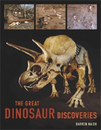

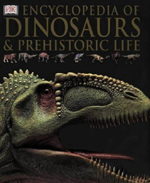
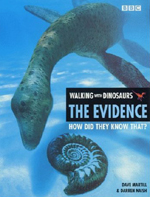
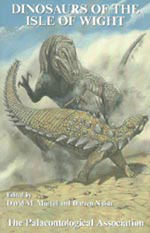









Comments
I don't know much about art, but I know what I like.
A duck convergent on Apteryx?
I like.
Posted by: Sven DiMilo | March 12, 2010 6:27 AM
Wwwwwwow. I had no idea. How is it even possible to miss the discovery of such a fascinating, uh, subfossil?
...oh. I don't read Catalogue of Organisms often enough. <wince>
Posted by: David Marjanović | March 12, 2010 6:42 AM
This is a joy. It makes me want to get my copy of Quirks out for a game.
Posted by: Neil | March 12, 2010 6:48 AM
loves it!
Posted by: Hanneke Meijer | March 12, 2010 7:04 AM
Hmm, I was getting ready to slip in a Harald Stümpke reference here, but looks like this is legit after all. :-)
Posted by: anon | March 12, 2010 7:23 AM
Anthropogenic extinction, eh? It's the height of hubris, the HEIGHT of it, to suggest man can have such an effect on God's creation.
j/k, I wish we weren't such dicks. This is a heck of a duck.
Posted by: David | March 12, 2010 8:48 AM
It really is amazing how much the original duck's bill has adapted to all kinds of new uses. Given that the sensitive filtering organ that is a duck's bill would appear to be a highly specialised tool, seeing it used as a leaf litter raker (Talpanas), a grazing tool (geese and swans),a extremely effective sieve (shovelers), a toothy ferndemolisher (moa nalo), for catching fish (mergansers), breaking open molluscs (eiders), perhaps predation(gastornithids, dromornithids and brontornithids) or to just see it adapted into something more or less degenerated and 'normalized' (screamers) really makes clear how flexible it is.
Posted by: Brian | March 12, 2010 9:39 AM
I'm wondering what the braincase of a New Zealand blue duck (Hymenolaimus) looks like. Does it have a big trigeminal? I don't recall ever seeing a skeletal specimen.
Posted by: John Harshman | March 12, 2010 9:43 AM
A slight oversight, the paper is freely available from the Smithsonian Digital Repository: http://tinyurl.com/yl5yoq5
Nick
Posted by: Nick Gardner | March 12, 2010 10:57 AM
There's no evidence that the screamers had duck-billed ancestors. They are the sister-group of all the rest of Anseriformes together (except for, possibly, any number of fossils; this is where gast-, bront- and dromornithids could fit, who knows).
Posted by: David Marjanović | March 12, 2010 11:04 AM
Question: what is the justification for only listing Olson and James as the authors of the taxon and not including the lead author of the paper itself? How would one cite such a thing? Would it be considered proper if one simply ignored the Olson and James bit and just cited the paper?
Posted by: jdmimic | March 12, 2010 11:35 AM
Does Hawaii have any living flightless or almost-flightless birds?
Posted by: gray Stanback | March 12, 2010 3:41 PM
"Olson & James in Iwaniuk, Olson & James, 2010".
Not if you need to cite the name, authors, and year. Though that rarely happens.
Posted by: David Marjanović | March 12, 2010 3:43 PM
@gray
the nēnē (hawaiian goose) is not flightless, but it is more highly adapted to a terrestrial than wetland environment than many waterfowl. it has greatly reduced webbing on its feet, longish claws for navigating lava rock, and it mates on land instead of in the water.
Posted by: brooks | March 12, 2010 4:03 PM
Alas no. AFAIK, the last known flightless birds here in Hawaii were a couple Porzana rails. Moho died out on the Big Island in the 1890's and the Laysan rail died out in the 1940's.
There are still endemic populations of Anas ducks (Laysan and Koloas), a coot and a moorhen. Along with the Nene. But I'm not sure if any have a reduce flight ability.
All I can do is look out on my lanai in Pearl City and imagine Grallistrix Owls stalking Moa-Nalos through the bush. While an Oahu Oo flies past. Cue sad violin music
Posted by: Sebastian Marquez | March 12, 2010 4:17 PM
What an amazing creature. Wish I could still see them scurrying around the islands...
Posted by: Kevin Schreck | March 12, 2010 5:03 PM
It looks so funny with those tiny little wings! They reminds me of the Laysan duck-Hawaii's modern-day flight-challenged waterfowl. Could it be that it wasn't entirely flightless, but was still capable of making short fluttering hops?
Posted by: gray Stanback | March 12, 2010 5:13 PM
Is Talpanas part of the Moa-Nalo radiation or a different stock altogether?
Posted by: Sebastian Marquez | March 12, 2010 5:39 PM
What? What?? Say it ain't so!!!!!
Posted by: Mike from Ottawa | March 12, 2010 10:03 PM
Thanks for comments everyone. I can't find any pictures of the Hymenolaimus skull (comment 8), so no idea about its trigeminal nerve either. Despite its specialised bill, however, it was said by Martin et al. (2007) to be primarily a visual feeder (as is Malacorhynchus), so it should be very different from Talpanas. I haven't found the time to wade through any of the character codings in Livezey's papers.
I totally agree with David (comment 10) about screamers: there's no reason to think that their characters (like short, hooked bill and long, unwebbed toes) are reversals - they must be assumed to be plesiomorphies. Olson & Feduccia (1980) had to argue that screamers descended from duck-billed, anatoid-like ancestors because, otherwise, their proposal of anseriform derivation from phalarope-like charadriiforms wouldn't work.
The affinities of Talpanas (comment 18) are uncertain at the moment. Moa-nalos are apparently derived from dabbling ducks (as first suggested by syringeal bulla morphology, and later confirmed by genetics), and it's conceivable that Talpanas is also derived from Anas I suppose. We await more study.
Refs - -
Martin, G. R., Jarrett, N. & Williams, M. 2007. Visual fields in Blue ducks Hymenolaimus malacorhynchus and Pink-eared ducks Malacorhynchus membranaceus: visual and tactile foraging. Ibis 149, 112-120.
Olson, S. L. & Feduccia, A. 1980. Presbyornis and the origin of the Anseriformes (Aves: Charadriomorphae). Smithsonian Contributions to Paleobiology 323, 1-24.
Posted by: Darren Naish | March 13, 2010 6:52 AM
Incredible!
I wonder what is a chance it is pathological specimen. Or juvenile?
Posted by: Jerzy | March 13, 2010 1:46 PM
Juveniles should have relatively larger, not smaller, eyes, and there's no way to get that huge opening for the trigeminal nerve through ontogenetic variation or any pathology I can think of.
Posted by: David Marjanović | March 13, 2010 2:29 PM
Thanks Darren. So...it's a platypus-billed duck? How oddly appropriate. I'm a sucker for symmetry
Posted by: Sebastian Marquez | March 14, 2010 1:33 PM
I'll admit to having done this a couple of times, where I had longstanding unpublished manuscripts describing new species, and then got together with a coauthor for a paper of wider scope that the descriptions could be dropped into (Scanlon and Lee 2000, Shea and Scanlon 2007). It's common practice these days on multi-author papers to give a statement about who did what, and the split authorship convention on taxonomic acts is the same kind of thing. Sure it's a pain to cite, but it's only about credit where it's due.
Posted by: John Scanlon FCD | March 15, 2010 12:00 AM
Interesting that there seems to have been more than one convergently evolved "kiwi analogue" on the Hawaiian Islands: the flightless anatid Talpanas on Kauai, and 2-3 species of flightless ibis, Apteribis, on Maui and Molokai, respectively.
Posted by: Dartian | March 15, 2010 3:38 AM